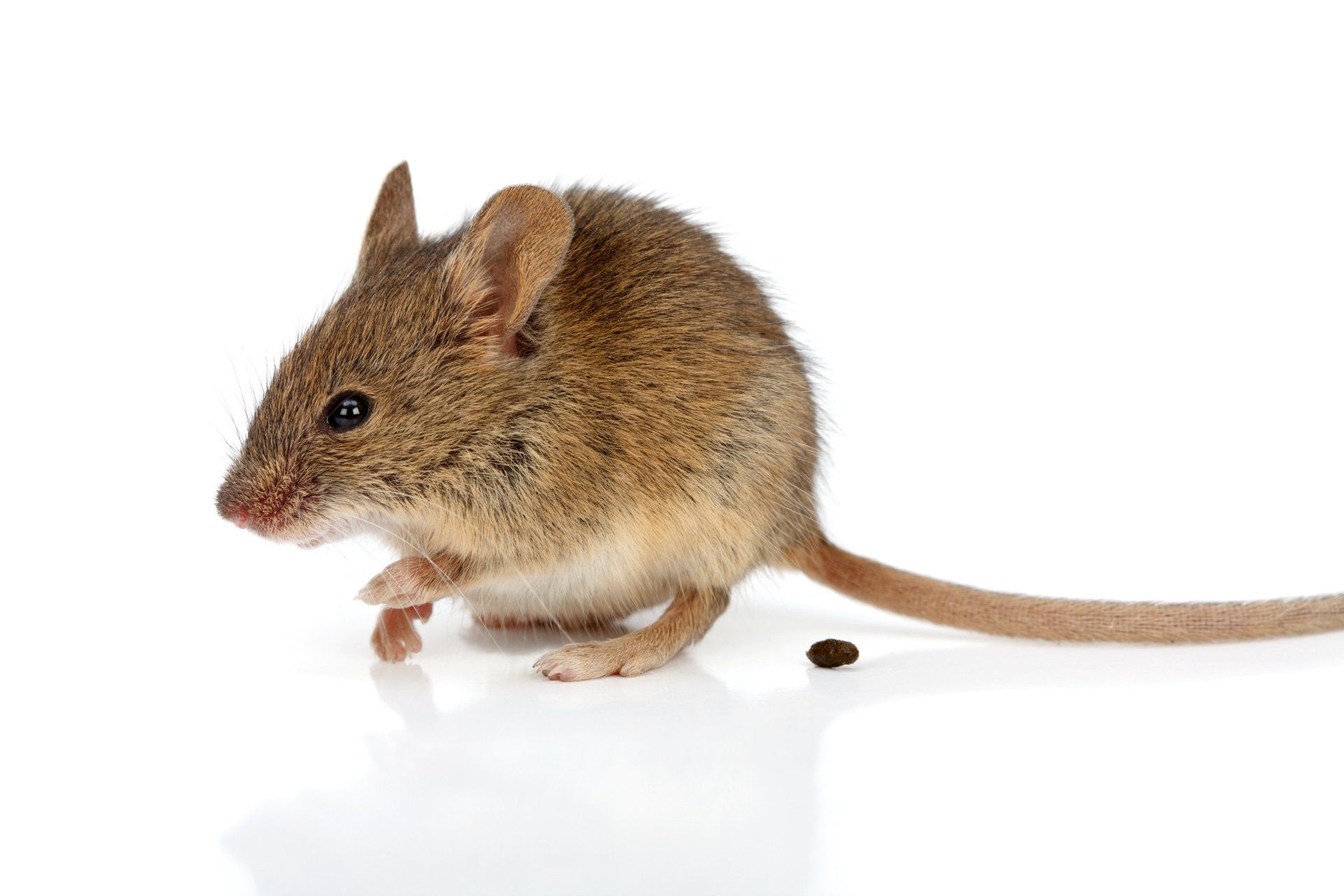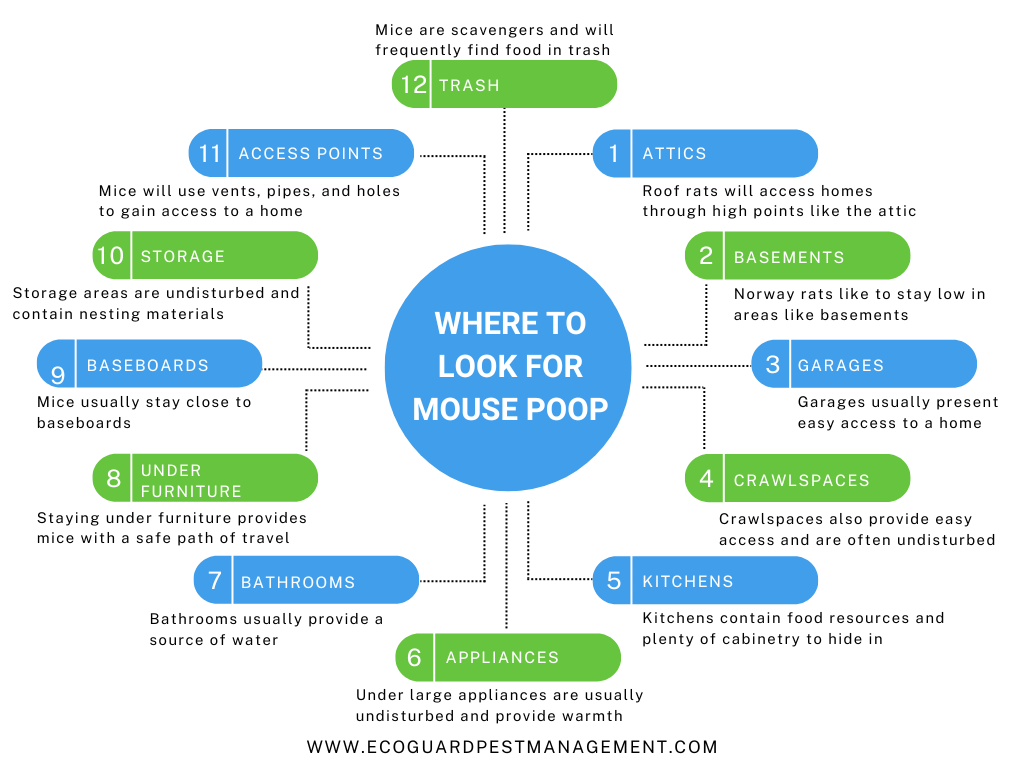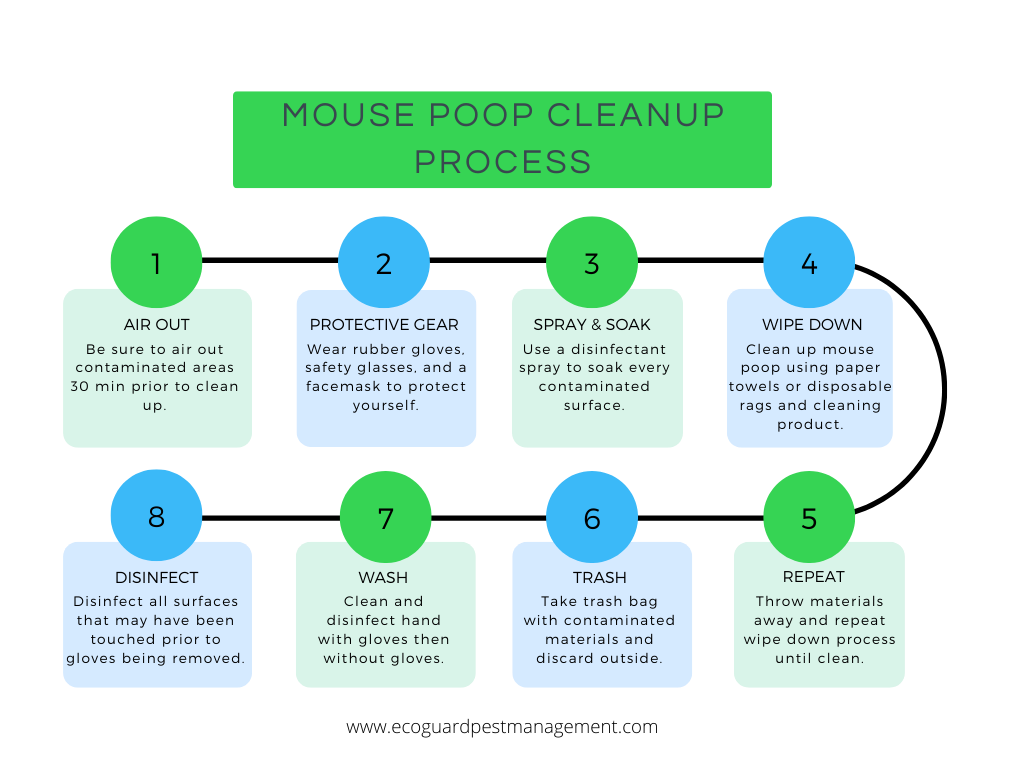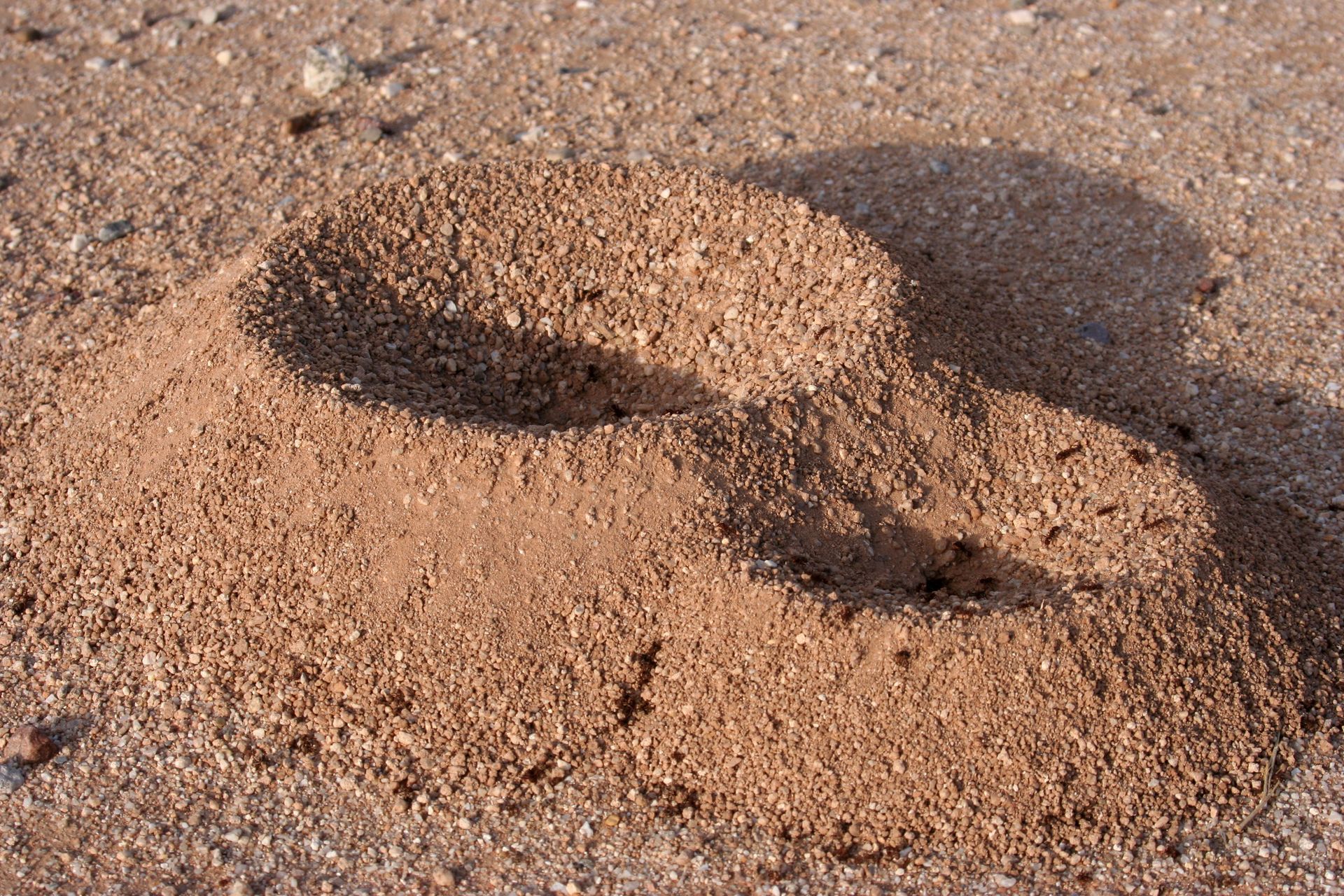What Does Mouse Poop Look Like?

Mouse poop looks like small dark brown or black granular pellets. Adult mice will poop pellets that are about a ¼ inch on average. They have pointed ends and look like seeds or small dark grains of rice. These pellets will start out black, and they will lose their color over time. Within the first week, the pellets will start to turn brown before fading to grey. Mice can leave between 50 – 75 pellets a day which can give you an idea of how severe of a problem you have. Mice also poop as they travel so it is more common to find mice feces along the mouse runways they use to traverse a home and by their food sources.
How To Identify Mouse Poop
Mouse poops are small, thin, pointed pellets that are black or dark brown. They are commonly mistaken for feces that belongs to other rodents or cockroaches which is why identification is sometimes difficult. Size is a good indicator that identifies the difference between rat vs mouse poop because mouse poop is much smaller than rat poop.
Mouse Poop Size Comparison
Mouse poop on average is ¼ inch long while rat droppings on average are between ½ inch to ¾ inch long. Cockroach waste is even smaller at 1/25 inch which looks like coarse black pepper.
List of Services
How Often Do Mice Poop?
Studies conducted by wildlife experts indicate that mice will defecate approximately between 50 – 75 times per day. Mice poop is rarely deposited in one area since mice will poop while they are exploring their territory, but it can build up rapidly if it goes unnoticed for a long time. The places that mouse poop will build up are often undisturbed areas where there is little human activity or areas that often go unchecked. It isn’t uncommon for large amounts of mouse feces to go unnoticed until furniture is moved, or until an area gets deep cleaned.
Where to Look for Mouse Droppings?
Since mice are nocturnal, seeing them when they’re active is rare. It is much more common to find mice droppings before actually seeing mice running around. This is why it is important to know where to look for mice poop if you suspect you have a mice problem. Mice regularly poop while they are on the move so their feces can be found everywhere they are active. It’s a good idea to check the following locations for mice poop if you think you have a mice problem.
- Attics, crawlspaces, basements, and garages
- Kitchen cabinets and pantries where food is stored or prepared.
- Around major appliances like refrigerator, laundry machine, and water heater
- Bathroom cabinets and under sinks
- Around vents, pipes, and exposed holes
- Under furniture
- Along baseboards
- Inside closets and other storage spaces
- Near trash

Does Mouse Poop Smell?
Mouse poop can build up quickly and leave a musty, stale smell wherever it is found. In small amounts, mice poop generally doesn’t smell like much, but in a short period of time enough of it will build up to become problematic. The smell of mouse urine is a much bigger problem and will require cleanup much earlier than mice droppings. Mice urine gives off a pungent ammonia smell that is unpleasant to humans. The other reason mouse urine should be cleaned up quickly is because other mice can be attracted to the pheromones in the urine. Male mice leave urinary pheromones that prompt a reproductive response in female mice. This has led to reproductive success which results in a rapid increase in infestation rates.
Mouse Poop Cleanup
Assuming that the mice have been removed from an area, clean up should follow immediately to ensure that an area is no longer contaminated with mouse feces. The CDC recommends following these precautions to help clean up mouse poop and urine:
- Air out any area being cleaned for at least 30 min prior to cleanup.
- Wear protective rubber gloves, glasses, and masks.
- Use a disinfectant spray (1 part bleach:10 parts water) and saturate every surface until thoroughly soaked and let soak for 5 minutes.
- Clear the area of as much mouse poop just using paper towels or disposable rags and cleaning product without the use of a broom or vacuum.
- Discard used paper towels containing mouse droppings in a covered trashcan.
- Repeat disinfecting step as many times as needed before final mop up and disinfectant spray down.
- Seal all the mouse feces and cleanup waste in a plastic bag and discard outside in a covered trash receptacle.
- Wash gloved hands with soap and water then disinfectant before removing gloves.
- Wash hands with soap and water after removing gloves.
- Disinfect anything that may have been touched with the gloves on the way to discarding trash bag.
It is important to not use a vacuum or broom because you don’t want to disrupt the mouse poop. There is dander, dust, allergens, and other dangerous pathogens that can become airborne if the mice poop is agitated. This could lead to members of the household getting sick.

Is Mouse Poop Dangerous?
Mouse poop can carry dangerous pathogens and bacteria that can cause serious illness. This is why handling mouse poop while cleaning should be done with caution. The following infectious rodent diseases can result from handling mouse feces incorrectly:
- Hantavirus: this disease affects the lungs and respiratory system and is caused when air contaminated with particles of rodent feces is breathed in
- Lymphocytic choriomeningitis: a neurological disease that can happen if an open wound comes into contact with mice feces
- Salmonellosis: an infection that is caused by consuming food or drink that has been contaminated by mice waste
- Rat bite fever: a bacterial infection that comes from being in contact with water or food contaminated with mice waste
- Leptospirosis: a bacterial infection that comes from being in contact with water or food contaminated with mice waste

It is recommended that cleanup is done with gloves, safety glasses, long sleeves & pants, and a facemask designed to filter out contaminants. Always clean your hands after coming in contact with mice feces and be sure to avoid touching your eyes, nose, or mouth until you are all done.
Disinfecting Mouse Droppings
After a final cleanup, a final disinfection is needed to eliminate any traces of harmful pathogens left behind. This will require:
- Cleaning all linens, bedding, and clothing that may be contaminated using hot water to remove rodent urine or feces.
- All hard surfaces and countertops will need to be disinfected following Centers for Disease Control and Prevention (CDC) protocol.
- Shampooing and steam cleaning any carpets and upholstery that may have been in contact with mice.
- After cleanup, be sure to clean the outfit that was used as well as give any parts of your body that were exposed to mice poop a good cleaning.
Cleaning Cabins, Sheds, Barns, & Other Structures
Out building like sheds and barns are more likely to have mice problems go unnoticed. This can lead to larger mouse infestations and much more mouse poop. Since the amount of mouse poop can be overwhelming, it is recommended that at least 30 minutes is given to air these structures out so the dust can settle. Once the area is aired out for an appropriate amount of time the normal mouse poop cleaning process can be implemented. When cleaning out these types of out structures, it is also recommended that any contaminated items be discarded and left downwind, so contaminants do not get blown towards the individual cleaning up.
Cleaning Attics, Basements, Crawlspaces, & Other Storage Areas
Cleaning up these parts of a home can be difficult because mice have no problem invading personal items or contaminating building materials. A few tips to help with mice poop cleanup in these areas are:
- Using a mask designed to filter out all pathogens is recommended in tight spaces.
- Dirt floors in basements and crawlspaces should still be saturated with disinfectant.
- Insulation is often contaminated and needs to be replaced.
- Contaminated boxes should be brought outside, and materials should be cleaned with a disinfectant solution.
- Contaminated materials should be cleaned while remaining upwind, so particulates are not inhaled.
- Contaminated materials deemed trash should be disposed of outside.
Cleaning Air Ducts & HVAC Systems
If there is evidence of mice poop in your HVAC system, it is time to call professional for some AC maintenance. Companies that specialize in cleaning air ducts will need to assess the damage to the ventilation system as well as clean or replace the current system where it is contaminated. Otherwise, the HVAC system could potentially be spreading harmful pathogens that come from the mouse poop to the entire house.
How to Know if the Mice are Still There?
The best way to find out if there are still mice infesting an area is to see if there is more mouse poop after an area has been thoroughly cleaned. If the mouse poop returns, then the mice have not been cleared out yet. The other method is to examine the poop and try and determine how old it looks. Fresh mouse poop is black and wet looking. This will eventually dry out and fade in color and sometimes grow mold. Seeing signs of fresh droppings is also another indicator that the mice are still active.
How to Prevent Mice
Dealing with a mice infestation can be a huge pain but with a few actionable pointers, you should be able to help get rid of mice quickly and prevent them from coming back.
- Strategically lay out mice snap traps to get rid of any existing mice.
- Seal all potential entry points to repel mice. Look for air vents, loose pipes, etc. and block access to your home.
- Clean debris and clutter that can be used as nesting material.
- Limit available resources and food by keeping all food stored properly.
- Keep trash to a minimum.
- Clear hiding areas in and around your home.
- Call professionals to help manage mice populations.
Contact EcoGuard Pest Management to Exterminate Mice
If your household is dealing with mice and have found mouse poop inside your home, call EcoGuard Pest Management to get a licensed rodent control expert out for a rodent inspection. Our team has years of experience dealing with different types of rodents and we know exactly how to effectively treat for mice.

















